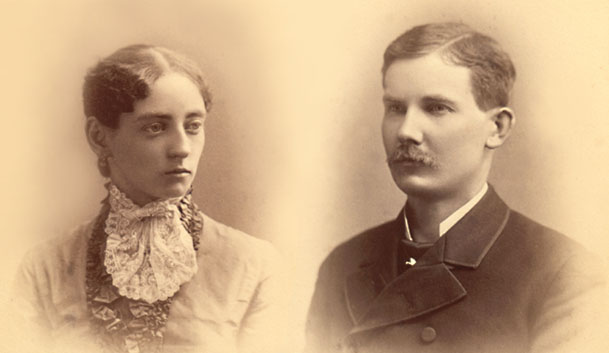
|
Hold your breath for a count of ten. Look, really look,
into these faces and you can begin to sense something of them. They are holding very still
and are also holding their breath. Just underneath the masks of seriousness you can feel
warmth, humor and a love deeply abiding enough to last a lifetime. This portrait sitting
was a matter of deep solemnity,
setting their marriage in place in a classic small town community. They were conscious of
posterity, immanent in the room. In the holding of a breath, there is wonder
and awe at who we might be, what the future will be. We are in the same room in 1880.
Charles was born in 1852, exactly a hundred years before I was. So when I get concerned about questions like, whether I live in anything like the same America they did, and how my life compares to what it might have been like in the time before technology and complexity, before the threats of nuclear annhilation, environmental sustainability, or terrorism, I find myself comparing their time to mine through the images of Charles and Helen. They built a house and set up a household in a time before television or radio. Electricity and then telephones only became part of their lives in middle age. I can envision them, sitting by the fire of evenings, which they needed for heat, telling jokes, stories and singing songs. They probably had lots of visitors who brought news of distant places with the wagon repairs in Charles' barn. Am I as much of a man as he was? Could he handle my larger set of options amid the sophistication and challenge of life at our faster pace? I feel sure that he and Helen were modern people and smart enough. They certainly look full of determination. I can see them with cell phones and a baby stroller on some jogging trail. She would look truly beautiful in modern fashions. I can see why he fell for her, and it even seems that maybe the photograph also conveys a deep, smoldering passion between them which they were hoping to suppress from view. The portrait sitting was very likely just before their wedding day, and this may capture their energy. They apparently went on to have a great marriage and were happy and made everyone around them happy for fifty years after the photographers' flash went off. Was that made possible by the times they lived in? Would their relationship have been sustainable under the pressures of our time? Charles moved from Connecticut to Albion, a small town in Western New York between Rochester and Buffalo just a few miles inland from Lake Ontario around 1870, when he would have been 18, give or take a few years. He lived in boarding houses in his early twenties and worked in barns and livery stables as a carpenter on carriages, buggies and wagons. He stayed in Albion and married Helen Herrick in 1880 when she was 21 and he was 27. They had four children, three of whom lived to adulthood. I wonder, as I look into the picture, why Charles had not gone out West. Were I in his shoes, the prospect would have held a strong, irresistable allure. He was obviously young and fit, and had a portable trade. Why didn't he? Getting married at 27 in a time when 15 year old marriages were common is a little unusual for someone who didn't get into a long term study as for medical practice. What was he doing in his early twenties? Perhaps Charles stayed in Connecticut long enough to complete an apprenticeship to learn a trade before going West. Around the wagon trade there would be lots of storytelling about all the excitement and adventure out on the trails. Being able to build and fix wagons and carriages would have been a skill in demand in this time of the wagon trains and westward migration. A lot of people would have been urging "Go west young man." He was too young to go to the Civil War, being 8 when it started and only 13 when it ended. He would have been able to leave home anytime after he was about 15 or 16. My family might have originated from Oregon instread of New York and Ohio if he had, creating another, possibly different story line for my life. Perhaps Charles was headed west and got as far as Albion, where a short stop to fix and repair and to make a little more money for the trip ahead might have led to a longer stay. At that time, Albion would have been beautiful, endearing and at its small town best. He might have fallen in love with the place. At some point, he fell in love with a beautiful young merchant's daughter. Her father, Hezekiah Beecher Herrick, probably had delivery wagons and was likely a client of Charles'. She lived at home still, at 21, in the 1880 census, and by 1892, she and Charles had an 11 year old daughter. Either they married and had a child pretty much immediately, or Helen was already pregnant when this picture was taken (depending on whether the marriage was in 1880 or 1881). In any case, dreams of going West had become dreams of love and building a life. They did that really well. None of their three children ventured out of the area. One son lived in the household from the day he was born in 1886, until the day he died in 1950. Pictures of him and his wife also show very happy and confident people. The talk in the family was that Charles' great grandfather had served in the Revolutionary War and that Aaron Burr had become a friend of the family for saving the young Heady's life when he dragged him out of the line of fire at an early battle. Indeed, Charles and Helen named a son Burr (1886), who also named a son Burr (1923), and that tradition continued into a third generation (1954). There was a Daniel Heady, a farmer from Litchfield, Connecticut, who received a pension after going to court in 1782 and asserting his revolutionary service, thus creating a record. Whether Charles can be directly connected to Daniel, is unclear. It may be that one or more family members followed Aaron Burr out west on his ill-fated venture to start an empire in Texas. One man named Heady was noted on the walls of he Alamo as having been a settler in San Antionio. A public notice published before the famous battle, noted his estate sale. They were probably cousins. Another Heady was a part of Stephen F. Austin's first colony, about a hundred miles to the east of San Antonio. It could be that the given name Burr is a vestige of Charles' nostalgia for the West. Family legend has it that Helen was related to Harriet Beecher Stowe and Henry Ward Beecher. Her father's name was Hezekiah Beecher Herrick and in the 1880 census the household she lived in included a 73 year old Mark H. Beecher, listed as an uncle. Another thing that seems visible in the bearing of Charles and Helen is a strong sense of pride in who they were, with roots in America's early culture and history. I must admit that I wasn't as inspired to explore very deeply these feelings before I inherited a collection of family photos, with some small heirloom objects that cause me to contemplate what American culture is and was. In the 1920s, Charles might have had the option of turning his livery stable into a motorized taxi business since after World War I, automobiles and trucks and road building to support them were quickly making the horse and buggy culture a thing of the past. But by then, he was past retirement age. I wonder if he ever so much as needed a can of oil or a gallon of gas before he died in 1930 at 78. If so, it would have been without any concern for the world supply of oil or the conflicts it would cause. Reportedly he sold the business, opting to go fishing every day on a nearby lake. Family legend had it that he died on that lake in May 1930, in his favorite fishing boat. But the obituary in the newspaper says he died from a brief illness at home. Helen died in the month of May as well, in 1934. Theirs was a different time. Charles and his friends, who were no doubt all skilled carpenters, built the two story house at 38 Clinton Street with their own hands and the family lived there until the house was sold following the death of Charles' son Burr's wife, Eula Gill in December, 1962. For a while, three generations of the Heady family lived there at the same time. It was such a solid house that workmen putting in a door took a whole day just to cut through the lath and plaster walls. My father, Burr Jr, remembered this as we contemplated a home repair task in a modern suburban ranch style home with gypsum wallboard walls, around 1970. Time was a difference, told in things like this. Our ancestors had time to do things well and they took the time without question as it was a basic value. "A thing worth doing is a thing worth doing well," I remember being reminded as a child. It was an echo from their time. The coins and currency below, which I inherited after my father passed away, are among the things left from their household. Some of them commemorate the Civil War. Charles would have been eight years old in 1860 when the war broke out, and might have enthusiastically collected these coins struck as some of the first national coinage produced in the US. Three of them are below.
Stuart Heady
|
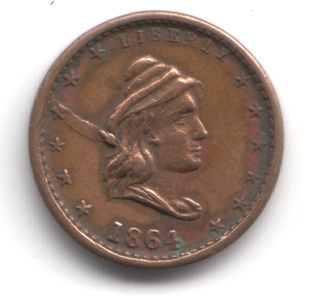 1864 Civil War Commemorative |
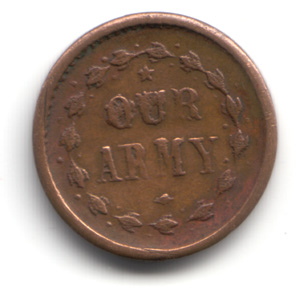
|
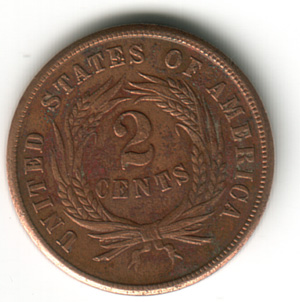 1864 Two Cent Piece. "Why, for two cents, I'd..." |
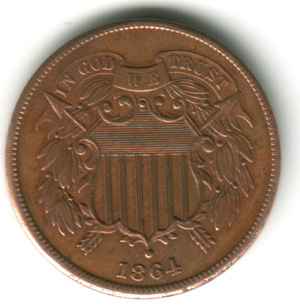
|
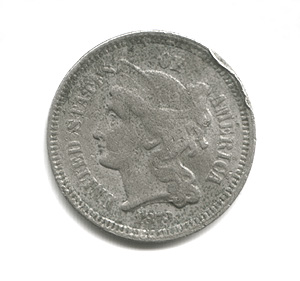 1873 Three Cent Tin Nickel |
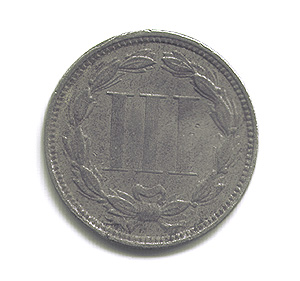
|